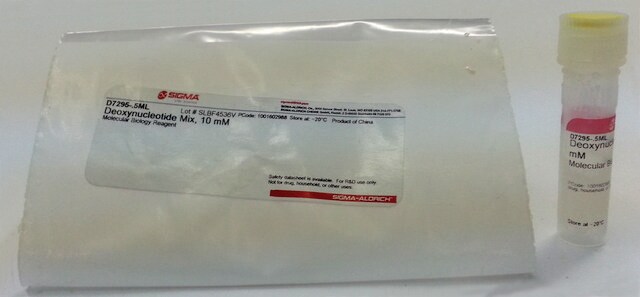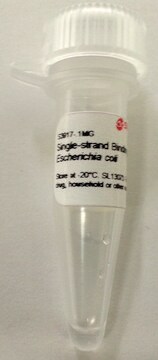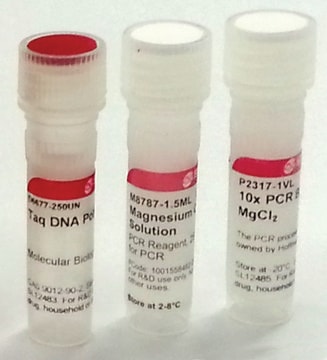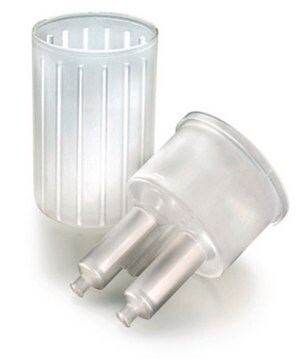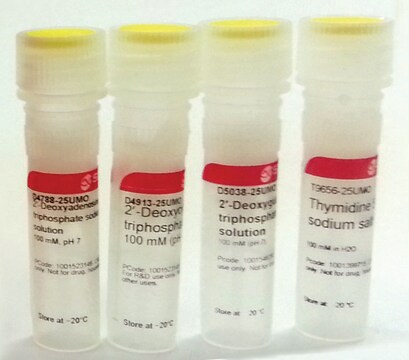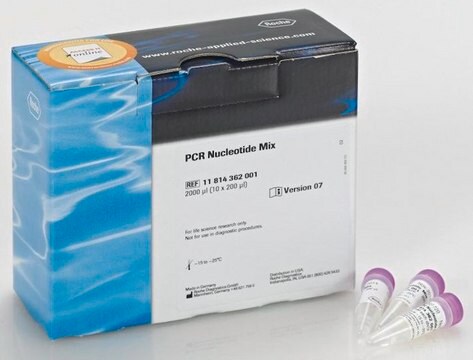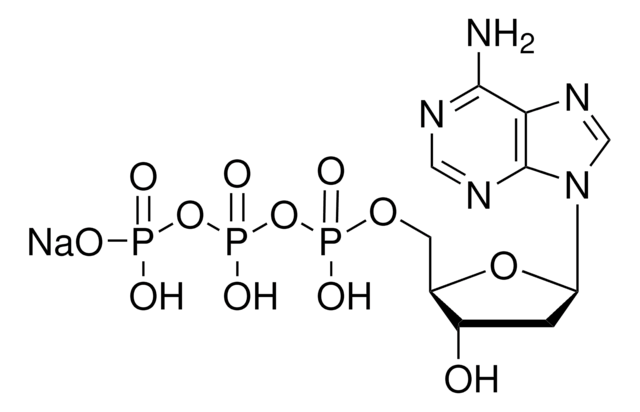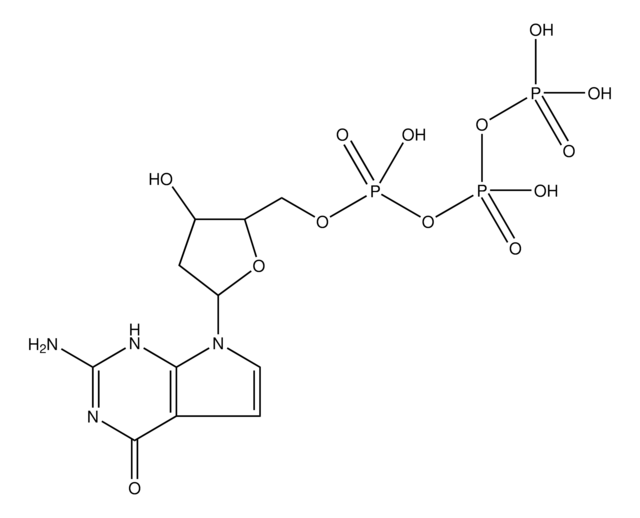DNTPCA1
CleanAmp™ dNTP
Hot-start dNTP mix for improved PCR
Synonyme(s) :
Deoxynucleotides, dNTP, dNTP Mix
Se connecterpour consulter vos tarifs contractuels et ceux de votre entreprise/organisme
About This Item
Code UNSPSC :
41106305
Produits recommandés
Forme
liquid
Caractéristiques
hotstart
Concentration
10 mM (each dNTP)
Couleur
colorless
Conditions d'expédition
dry ice
Température de stockage
−20°C
Vous recherchez des produits similaires ? Visite Guide de comparaison des produits
Description générale
We are proud to offer new, improved, CleanAmp dNTPs. CleanAmp dNTPs are modified nucleoside triphosphates that block DNA polymerase nucleotide incorporation. CleanAmp dNTPs are activated by the initial heating step and subsequent denaturing steps in typical hot start PCR cycling conditions. This process limits the amount of activated dNTPs during each cycle of PCR, allowing for more specific and efficient amplification of the desired product and also reducing or completely avoiding mis-priming or primer dimer formation. CleanAmp dNTPs provide a more affordable solution than hot start enzymes for a variety of PCR-based applications.
CleanAmp dNTPs, are a product of TriLink BioTechnologies, Inc. CleanAmp dNTPs are modified nucleoside triphosphates that block DNA polymerase nucleotide incorporation. CleanAmp dNTPs are activated by the initial heating step and subsequent denaturing steps in typical hot start PCR cycling conditions. This process limits the amount of activated dNTPs during each cycle of PCR, allowing for more specific and efficient amplification of the desired product and also reducing or completely avoiding mis-priming or primer dimer formation. CleanAmp dNTPs provide a more affordable solution than hot start enzymes for a variety of PCR-based applications.
Application
- For PCR amplifications that require reduced non-specific amplification
- For multiplex PCR
- For reduction of primer dimers
- Substitute for dNTPs in any PCR reaction
Conditionnement
2 μmoles: 1 vial, 200 μL, each dNTP at 10 mM in 50 mM Glycine
10 μmoles: 1 vial, 1000 μL, each dNTP at 10 mM in 50 mM Glycine
10 μmoles: 1 vial, 1000 μL, each dNTP at 10 mM in 50 mM Glycine
Informations légales
CleanAmp™ dNTPs are provided to buyer with a non-transferrable right from TriLink BioTechnologies, Inc. to use the purchased CleanAmp™ dNTPs in internal research conducted by the buyer, whether the buyer is an academic, non-profit, or for-profit entity. CleanAmp™ dNTPs are not to be used for human therapeutic or commercial clinical diagnostic use. A license is required for any commercial use of CleanAmp™ dNTPs, regardless of the academic or non-profit status of the using entity. Information about commercial licenses for CleanAmp™ dNTPs may be obtained from TriLink BioTechnologies, Inc. Buyer may not use the CleanAmp™ dNTPs to support the filing of a patent application in any country in the world that contains claims directed to CleanAmp™ dNTPs or uses thereof without the express approval of TriLink BioTechnologies, Inc. Buyer′s right to have and use the CleanAmp™ dNTPs will terminate immediately if you fail to comply with these terms and conditions of this agreement.
CleanAmp is a trademark of TriLink BioTechnologies, Inc.
Code de la classe de stockage
12 - Non Combustible Liquids
Classe de danger pour l'eau (WGK)
WGK 2
Point d'éclair (°F)
Not applicable
Point d'éclair (°C)
Not applicable
Faites votre choix parmi les versions les plus récentes :
Déjà en possession de ce produit ?
Retrouvez la documentation relative aux produits que vous avez récemment achetés dans la Bibliothèque de documents.
Les clients ont également consulté
Elena Hidalgo Ashrafi et al.
Current protocols in molecular biology, Chapter 15, Unit 15-Unit 15 (2009-10-10)
Hot-start PCR is a technique that improves PCR performance by reducing nonspecific amplification during the initial setup stages of the PCR. This unit describes hot-start PCR protocols which utilize primers containing temperature-sensitive modifications. The introduction of 4-oxo-tetradecyl (OXT) phosphotriester groups
Natasha Paul et al.
Methods in molecular biology (Clifton, N.J.), 630, 301-318 (2010-03-20)
Hot Start activation approaches are increasingly being used to improve the performance of PCR. Since the inception of Hot Start as a means of blocking DNA polymerase extension at lower temperatures, a number of approaches have been developed that target
Inna Koukhareva et al.
Nucleic acids symposium series (2004), (52)(52), 259-260 (2008-09-09)
Several 3'-ether and 3'-ester derivatives of 2'-deoxyribonucleoside 5'-triphosphates (dNTPs) were prepared. These dNTP derivatives were not substrates for DNA polymerase and did not support primer extension at room temperature. However, by short pre-heating to 95 degrees C in PCR buffer
Franck Court et al.
Genome biology, 12(5), R42-R42 (2011-05-17)
Despite its critical role for mammalian gene regulation, the basic structural landscape of chromatin in living cells remains largely unknown within chromosomal territories below the megabase scale. Here, using the 3C-qPCR method, we investigate contact frequencies at high resolution within
Xinglong Xiao et al.
Journal of virological methods, 187(2), 357-361 (2012-11-13)
Nucleic acid testing (NAT) is valuable for screening blood donors for occult hepatitis B virus (HBV) infection and infection during the window period in countries where HBV is endemic, such as China. An "in-house" NAT (Triplex NAT) was developed for
Notre équipe de scientifiques dispose d'une expérience dans tous les secteurs de la recherche, notamment en sciences de la vie, science des matériaux, synthèse chimique, chromatographie, analyse et dans de nombreux autres domaines..
Contacter notre Service technique